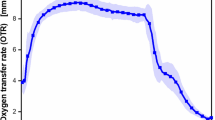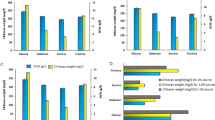Abstract
The effects of switching morphology and replacing supplementary nutrients with fungal extract (5 and 10 g/L) on the production of major metabolites and chitosan by Mucor rouxii were investigated. This approach was supposed to promote sustainability of the fermentation process and improve its economic feasibility. Different fungal morphologies, i.e., purely filamentous (PF), purely yeast-like (PY), mostly filamentous (MF), and mostly yeast-like (MY), were evaluated. The highest ethanol yields were obtained from the media supplemented with 10 g/L fungal extract for all morphologies, while adding nutrient salts did not make any improvements in these yields, except a slight decrease in the fermentation time. Except for PF morphology, the replacement of yeast extract favored the biomass production yields. Moreover, the alkali insoluble material (AIM) yields were higher as a result of the replacement for most cases. Furthermore, the replacement resulted in increased glucosamine and decreased N-acetyl-glucosamine content of AIM for almost all the morphologies. AIM yields of at least 0.25 g/g-glucose and maximum chitin/chitosan yield of 0.78 g/g-AIM were obtained from the solids remaining after autolysis process, which were higher than that obtained from the raw biomass. The maximum yield of 0.135 g/g-AIM purified chitosan with intact molecular weight was obtained from the biomass with PF morphology supplemented with 10 g/L fungal extract plus nutrients.






Similar content being viewed by others
References
Dekina, S., Romanovska, I., Sevastyanov, O., Shesterenko, Y., Ryjak, A., Varbanets, L., Natalia, D., & Muratov, E. (2020). Development and characterization of chitosan/polyvinyl alcohol polymer material with elastolytic and collagenolytic activities. Enzyme and Microbial Technology, 132, 109399.
Dash, M., Chiellini, F., Ottenbrite, R. M., & Chiellini, E. (2011). Chitosan—a versatile semi-synthetic polymer in biomedical applications. Progress in Polymer Science, 36(8), 981–1014.
Zamani, A., Jeihanipour, A., Edebo, L., Niklasson, C., & Taherzadeh, M. J. (2008). Determination of glucosamine and N-acetyl glucosamine in fungal cell walls. Journal of Agricultural and Food Chemistry, 56(18), 8314–8318.
Teli, M. D., & Sheikh, J. (2012). Extraction of chitosan from shrimp shells waste and application in antibacterial finishing of bamboo rayon. International Journal of Biological Macromolecules, 50(5), 1195–1200.
Venkatesan, J., & Kim, S.-K. (2010). Chitosan composites for bone tissue engineering--an overview. Marine Drugs, 8(8), 2252–2266.
Naghdi M, Zamani A, Karimi K (2014) A sulfuric–lactic acid process for efficient purification of fungal chitosan with intact molecular weight. International Journal of Biological Macromolecules, 63 (0):158–162.
Ghormade, V., Pathan, E. K., & Deshpande, M. V. (2017). Can fungi compete with marine sources for chitosan production? International Journal of Biological Macromolecules, 104(Pt B), 1415–1421.
Dhillon, G. S., Kaur, S., Brar, S. K., & Verma, M. (2013). Green synthesis approach: extraction of chitosan from fungus mycelia. Critical Reviews in Biotechnology, 33(4), 379–403.
Zininga, J. T., Puri, A. K., Govender, A., Singh, S., & Permaul, K. (2019). Concomitant production of chitosan and lipids from a newly isolated Mucor circinelloides ZSKP for biodiesel production. Bioresource Technology, 272, 545–551.
Ramos Berger, L. R., Montenegro Stamford, T. C., de Oliveira, K. Á. R., de Miranda Pereira Pessoa, A., de Lima, M. A. B., Estevez Pintado, M. M., Saraiva Câmara, M. P., de Oliveira, F. L., Magnani, M., & de Souza, E. L. (2018). Chitosan produced from Mucorales fungi using agroindustrial by-products and its efficacy to inhibit Colletotrichum species. International Journal of Biological Macromolecules, 108, 635–641.
Tasar, O. C., Erdal, S., & Taskin, M. (2016). Chitosan production by psychrotolerant Rhizopus oryzae in non-sterile open fermentation conditions. International Journal of Biological Macromolecules, 89, 428–433.
Okamoto, K., Nitta, Y., Maekawa, N., & Yanase, H. (2011). Direct ethanol production from starch, wheat bran and rice straw by the white rot fungus Trametes hirsuta. Enzyme and Microbial Technology, 48(3), 273–277.
Satari, B., & Karimi, K. (2018). Mucoralean fungi for sustainable production of bioethanol and biologically active molecules. Applied Microbiology and Biotechnology, 102(3), 1097–1117.
Karimi, K., Brandberg, T., Edebo, L., & Taherzadeh, M. (2005). Fed-batch cultivation of Mucor indicus in dilute-acid lignocellulosic hydrolyzate for ethanol production. Biotechnology Letters, 27(18), 1395–1400.
Karimi, K., Emtiazi, G., & Taherzadeh, M. J. (2006). Ethanol production from dilute-acid pretreated rice straw by simultaneous saccharification and fermentation with Mucor indicus, Rhizopus oryzae, and Saccharomyces cerevisiae. Enzyme and Microbial Technology, 40(1), 138–144.
Karimi, K., Emtiazi, G., & Taherzadeh, M. J. (2006). Production of ethanol and mycelial biomass from rice straw hemicellulose hydrolyzate by Mucor indicus. Process Biochemistry, 41(3), 653–658.
Sharifia, M., Karimi, K., & Taherzadeh, M. (2008). Production of ethanol by filamentous and yeast-like forms of Mucor indicus from fructose, glucose, sucrose, and molasses. Journal of Industrial Microbiology and Biotechnology, 35(11), 1253–1259.
Abedinifar, S., Karimi, K., Khanahmadi, M., & Taherzadeh, M. J. (2009). Ethanol production by Mucor indicus and Rhizopus oryzae from rice straw by separate hydrolysis and fermentation. Biomass and Bioenergy, 33(5), 828–833.
Lennartsson, P. R., Karimi, K., Edebo, L., & Taherzadeh, M. J. (2009). Effects of different growth forms of Mucor indicus on cultivation on dilute-acid lignocellulosic hydrolyzate, inhibitor tolerance, and cell wall composition. Journal of Biotechnology, 143(4), 255–261.
Heidary Vinche, M., Asachi, R., Zamani, A., & Karimi, K. (2012). Ethanol and chitosan production from wheat hydrolysate by Mucor hiemalis. Journal of Chemical Technology and Biotechnology, (88), 255–260.
Beheshti, H., & Karimi, K. (2016). Ethanol and value-added byproducts from rice straw by dimorphic fungus Mucor hiemalis. Engineeing in Life Science, 16(8), 750–761.
Safaei, Z., Karimi, K., & Zamani, A. (2016). Impact of phosphate, potassium, yeast extract, and trace metals on chitosan and metabolite production by Mucor indicus. International Journal of Molecular Sciences, 17(9).
Satari, B., Karimi, K., Taherzadeh, M., & Zamani, A. (2016). Co-production of fungal biomass derived constituents and ethanol from citrus wastes free sugars without auxiliary nutrients in airlift bioreactor. International Journal of Molecular Sciences, 17(3), 302.
Satari, B., Karimi, K., & Zamani, A. (2016). Oil, chitosan, and ethanol production by dimorphic fungus Mucor indicus from different lignocelluloses. Journal of Chemical Technology and Biotechnology, 91(6), 1835–1843.
Reis, C. E. R., Zhang, J., & Hu, B. (2014). Lipid accumulation by pelletized culture of Mucor circinelloides on corn stover hydrolysate. Applied Biochemistry and Biotechnology, 174(1), 411–423.
Sheldon, R. A. (2018). Chemicals from renewable biomass: a renaissance in carbohydrate chemistry. Current Opinion in Green and Sustainable Chemistry, 14, 89–95.
Satari, B., Karimi, K., & Kumar, R. (2019). Cellulose solvent-based pretreatment for enhanced second-generation biofuel production: a review. Sustainable Energy & Fuels, 3(1), 11–62.
Liu, Z., Liao, W., & Liu, Y. (2016). A sustainable biorefinery to convert agricultural residues into value-added chemicals. Biotechnology for Biofuels, 9(1), 197.
Suzuki, T., Hoshino, T., & Matsushika, A. (2019). High-temperature ethanol production by a series of recombinant xylose-fermenting Kluyveromyces marxianus strains. Enzyme and Microbial Technology, 129, 109359.
Zhao, Q., Wang, L., & Chen, H. (2019). Effect of novel pretreatment of steam explosion associated with ammonium sulfite process on enzymatic hydrolysis of corn straw. Applied Biochemistry and Biotechnology, 189(2), 485–497.
Satari, B., Karimi, K., & Molaverdi, M. (2018). Structural features influential to enzymatic hydrolysis of cellulose-solvent-based pretreated pinewood and elmwood for ethanol production. Bioprocess and Biosystems Engineering, 41(2), 249–264.
Berlowska, J., Dudkiewicz-Kołodziejska, M., Pawlikowska, E., Pielech-Przybylska, K., Balcerek, M., Czysowska, A., & Kregiel, D. (2017). Utilization of post-fermentation yeasts for yeast extract production by autolysis: the effect of yeast strain and saponin from Quillaja saponaria. Journal of the Institute of Brewing, 123(3), 396–401.
Li, M., Liao, X., Zhang, D., Du, G., & Chen, J. (2011). Yeast extract promotes cell growth and induces production of polyvinyl alcohol-degrading enzymes. Enzyme research, 2011, 179819–179819.
Jacob, F. F., Striegel, L., Rychlik, M., Hutzler, M., & Methner, F.-J. (2019). Spent yeast from brewing processes: a biodiverse starting material for yeast extract production. Fermentation, 5(2), 51.
Hahn-Hägerdal, B., Karhumaa, K., Larsson, C. U., Gorwa-Grauslund, M., Görgens, J., & van Zyl, W. H. (2005). Role of cultivation media in the development of yeast strains for large scale industrial use. Microbial Cell Factory, 4, 31–31.
Shi, X., Liu, Y., Dai, J., Liu, X., Dou, S., Teng, L., Meng, Q., Lu, J., Ren, X., & Wang, R. (2019). A novel integrated process of high cell-density culture combined with simultaneous saccharification and fermentation for ethanol production. Biomass and Bioenergy, 121, 115–121.
Asachi, R., & Karimi, K. (2013). Enhanced ethanol and chitosan production from wheat straw by Mucor indicus with minimal nutrient consumption. Process Biochemistry, 48(10), 1524–1531.
Safaei, Z., Karimi, K., Golkar, P., & Zamani, A. (2015). Effects of plant growth hormones on Mucor indicus growth and chitosan and ethanol production. International Journal of Molecular Sciences, 16(7), 16683–16694.
Mohammadi, M., Zamani, A., & Karimi, K. (2013). Effect of phosphate on glucosamine production by Ethanolic fungus Mucor indicus. Applied Biochemistry and Biotechnology, 171(6), 1465–1472.
Mohammadi, M., Zamani, A., & Karimi, K. (2012). Determination of glucosamine in fungal cell walls by high-performance liquid chromatography (HPLC). Journal of Agricultural and Food Chemistry, 60(42), 10511–10515.
Karimi, K., & Zamani, A. (2013). Mucor indicus: biology and industrial application perspectives: a review. Biotechnology Advances, 31(4), 466–481.
Goshadrou A, Karimi K, Taherzadeh MJ (2013) Ethanol and biogas production from birch by NMMO pretreatment. Biomass and Bioenergy, 49 (0):95–101.
Pillai, C. K. S., Paul, W., & Sharma, C. P. (2009). Chitin and chitosan polymers: chemistry, solubility and fiber formation. Progress in Polymer Science, 34(7), 641–678.
Author information
Authors and Affiliations
Corresponding author
Ethics declarations
Conflict of Interest
The authors declare that they have no conflicts of interest.
Additional information
Publisher’s Note
Springer Nature remains neutral with regard to jurisdictional claims in published maps and institutional affiliations.
Rights and permissions
About this article
Cite this article
Abasian, L., Shafiei Alavijeh, R., Satari, B. et al. Sustainable and Effective Chitosan Production by Dimorphic Fungus Mucor rouxii via Replacing Yeast Extract with Fungal Extract. Appl Biochem Biotechnol 191, 666–678 (2020). https://doi.org/10.1007/s12010-019-03220-w
Received:
Accepted:
Published:
Issue Date:
DOI: https://doi.org/10.1007/s12010-019-03220-w




